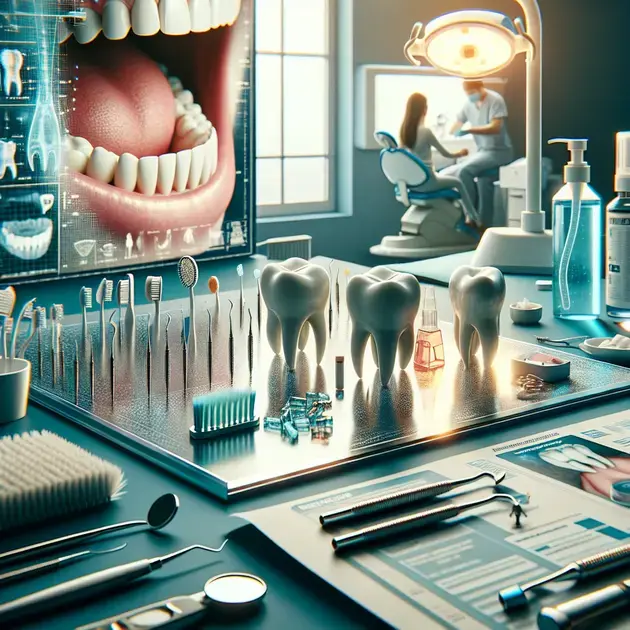When it comes to oral health, one common issue that many individuals face is decay between teeth. Understanding the causes, symptoms, and treatment options for decay between teeth is crucial for maintaining a healthy smile.
Recent studies have shown that poor oral hygiene habits, such as irregular brushing and flossing, are significant contributors to decay between teeth. Additionally, consuming sugary and acidic foods can also increase the risk of developing this dental problem.

Causes of Decay Between Teeth
Decay between teeth can be caused by a variety of factors. One common cause is poor oral hygiene, which allows plaque to build up between the teeth. Plaque contains bacteria that produce acids, leading to tooth decay. Another cause is consuming sugary and acidic foods and drinks, which can erode the enamel between the teeth, making them more susceptible to decay.
To prevent decay between teeth, it is essential to brush and floss regularly to remove plaque. Using a fluoride toothpaste can also help strengthen the enamel and prevent decay. Avoiding sugary and acidic foods can further reduce the risk of decay. Visiting the dentist for regular check-ups and cleanings is crucial in detecting and treating decay early.
Step-by-step guide:
- Brush your teeth at least twice a day with a fluoride toothpaste.
- Floss between your teeth daily to remove plaque and food particles.
- Avoid sugary and acidic foods and drinks that can contribute to decay.
- Visit your dentist every six months for check-ups and cleanings.
Symptoms to Watch For
Knowing the symptoms of decay between teeth can help you identify and address the issue promptly. Common symptoms include tooth sensitivity, especially when consuming hot, cold, sweet, or acidic foods. You may also experience toothache or pain when biting down on food. Visible holes or pits in the teeth are signs of advanced decay.
If you notice any of these symptoms, it is essential to schedule an appointment with your dentist for evaluation and treatment. Ignoring the symptoms can lead to further damage and potential tooth loss.
Step-by-step guide:
- Pay attention to tooth sensitivity to hot, cold, sweet, or acidic stimuli.
- Note any tooth pain or discomfort when eating or biting down.
- Check for visible signs of decay such as holes or pits in the teeth.
- Schedule a dental appointment promptly if you experience any of these symptoms.
Effective Treatment Options
When decay between teeth is detected, various treatment options are available to address the issue. The treatment approach depends on the severity of the decay. In the early stages, the decay can be treated with dental fillings to restore the damaged tooth structure. For more extensive decay, a root canal procedure may be necessary to remove the infected pulp.
In cases where the decay has progressed significantly, a dental crown or bridge may be recommended to cover and protect the affected teeth. In severe cases of decay, tooth extraction may be the only viable treatment option to prevent further complications.
Step-by-step guide:
- Consult with your dentist to determine the best treatment option based on the extent of decay.
- If dental fillings are recommended, schedule an appointment for the procedure.
- For advanced decay, discuss the possibility of a root canal or crown with your dentist.
- Follow post-treatment care instructions provided by your dentist for optimal recovery.

**Signs of Interdental Decay**
Introduction
Interdental decay, also known as decay between the teeth, is a common dental issue that can lead to serious oral health problems if not addressed promptly. This type of decay occurs when bacteria in the mouth feed on sugars and produce acids that erode the enamel between the teeth, causing cavities to form. Recognizing the signs of interdental decay is crucial for early detection and treatment to prevent further complications.
Visible Holes or Dark Spots
One of the most noticeable signs of interdental decay is the presence of visible holes or dark spots between the teeth. These spots may indicate the formation of cavities that have developed as a result of enamel erosion. If you notice any discoloration or pits in the areas between your teeth, it is essential to seek dental care promptly to prevent the decay from progressing.
Sensitivity to Hot and Cold Foods
Another common symptom of interdental decay is increased sensitivity to hot and cold foods and beverages. The erosion of enamel between the teeth can expose the inner layers of the tooth, leading to heightened sensitivity when consuming foods at extreme temperatures. If you experience discomfort or pain when eating or drinking hot or cold items, it is recommended to consult with a dentist for evaluation and treatment.
Bleeding Gums
Interdental decay can also contribute to gum issues, such as bleeding gums. As decay progresses between the teeth, it can irritate the surrounding gum tissues, causing inflammation and bleeding. If you notice bleeding gums during brushing or flossing, it may indicate the presence of interdental decay that requires professional intervention to prevent further damage to the teeth and gums.
Unpleasant Taste or Breath
When interdental decay is left untreated, it can result in an unpleasant taste in the mouth or persistent bad breath. The accumulation of bacteria and food particles in the decaying areas between the teeth can lead to foul odors and taste. Addressing the underlying decay through proper dental care and hygiene practices can help alleviate these symptoms and restore oral freshness.
Pain or Discomfort
Severe interdental decay may cause pain or discomfort, especially when chewing or biting down on food. The presence of cavities and decayed areas between the teeth can expose the nerves within the tooth, leading to sharp or throbbing pain sensations. Seeking immediate dental attention is crucial to address the decay and alleviate the associated discomfort.
**Preventive Measures for Tooth Decay**
Introduction
Preventing tooth decay is essential for maintaining optimal oral health and avoiding costly dental treatments in the future. Implementing proactive preventive measures can help reduce the risk of tooth decay and ensure a healthy smile for years to come. By incorporating simple yet effective strategies into your daily routine, you can protect your teeth from decay and maintain a bright, confident smile.
Brushing and Flossing Daily
One of the most fundamental preventive measures for tooth decay is consistent brushing and flossing. Proper oral hygiene practices help remove plaque, bacteria, and food particles that can contribute to decay. Brush your teeth at least twice a day with fluoride toothpaste and floss daily to clean between the teeth and along the gumline. This regular routine can significantly reduce the buildup of harmful substances that cause decay.
Limiting Sugary and Acidic Foods
Excessive consumption of sugary and acidic foods and beverages can increase the risk of tooth decay. Sugars and acids fuel the growth of bacteria in the mouth, leading to enamel erosion and cavity formation. Limit your intake of sugary snacks, carbonated drinks, and acidic foods to protect your teeth from decay. Opt for healthier alternatives and rinse your mouth with water after consuming such items to help neutralize the acids.
Regular Dental Check-ups
Scheduling routine dental check-ups is crucial for preventive care and early detection of tooth decay. Dentists can perform comprehensive examinations, cleanings, and screenings to assess your oral health and identify any signs of decay or other issues. Attending regular dental appointments allows for timely interventions and preventive treatments to preserve your teeth and prevent decay from progressing.
Fluoride Treatments
Fluoride is a mineral that strengthens tooth enamel and helps protect against decay. Dentists may recommend fluoride treatments or prescription fluoride products to enhance the resistance of your teeth to acid attacks and cavity formation. Incorporating fluoride into your dental care regimen can provide added protection against decay and support overall oral health.
Use of Dental Sealants
Dental sealants are thin protective coatings applied to the chewing surfaces of molars and premolars to seal off the deep grooves and crevices where bacteria can accumulate. Sealants act as a barrier against decay-causing substances, reducing the risk of cavities in these vulnerable areas. Discuss the option of dental sealants with your dentist to enhance the preventive measures against tooth decay.
**Importance of Regular Dental Check-ups**
Introduction
Regular dental check-ups are essential for maintaining optimal oral health and preventing dental problems before they escalate. Dentists play a critical role in monitoring your oral health, identifying potential issues, and providing timely interventions to preserve your teeth and gums. By scheduling routine dental appointments, you can benefit from professional care, preventive treatments, and personalized advice to achieve a healthy and confident smile.
Early Detection of Dental Issues
One of the primary advantages of regular dental check-ups is the early detection of dental issues such as tooth decay, gum disease, and oral infections. Dentists can visually inspect your teeth, gums, and mouth for signs of abnormalities or underlying problems that may require treatment. Detecting dental issues in their early stages allows for prompt interventions to prevent further complications and preserve oral health.
Professional Cleanings and Preventive Care
During dental check-ups, dental hygienists perform professional cleanings to remove plaque, tartar, and stains from the teeth. Professional cleanings help maintain oral hygiene, prevent gum disease, and reduce the risk of tooth decay. Dentists may also provide preventive treatments such as fluoride applications, dental sealants, and oral hygiene instructions to support your oral health goals and prevent dental problems.
Personalized Oral Health Recommendations
Dentists can offer personalized oral health recommendations based on your specific needs, risk factors, and preferences. Whether you require dietary advice, oral hygiene tips, or treatment options for existing dental issues, dentists can provide tailored guidance to help you achieve and maintain a healthy smile. By following the recommendations and advice from your dental care team, you can optimize your oral health outcomes and prevent future dental problems.
Monitoring Oral Health Changes
Regular dental check-ups enable dentists to monitor changes in your oral health over time and track the progression of existing conditions. By scheduling consistent appointments, you allow dentists to assess the effectiveness of treatments, identify emerging issues, and adjust your dental care plan accordingly. Monitoring oral health changes through regular check-ups promotes proactive management of dental issues and ensures ongoing oral health maintenance.
Promoting Overall Health and Well-being
Maintaining good oral health through regular dental check-ups is not only beneficial for your teeth and gums but also for your overall health and well-being. Research has shown links between oral health and systemic conditions such as cardiovascular disease, diabetes, and respiratory infections. By prioritizing regular dental visits, you can contribute to your overall health and reduce the risk of potential health complications associated with poor oral hygiene.
Conclusion
Interdental decay poses significant risks to oral health when left untreated, as highlighted by visible holes, sensitivity to temperature changes, bleeding gums, bad taste or breath, and discomfort. Recognizing these signs early on is crucial for prompt intervention and prevention of further complications. By seeking timely dental care, individuals can address interdental decay effectively and maintain their oral health.
Implementing preventive measures such as daily brushing and flossing, limiting sugary foods, attending regular dental check-ups, opting for fluoride treatments, and considering dental sealants can significantly reduce the risk of tooth decay. These strategies not only protect enamel but also contribute to long-term oral health and a confident smile. Incorporating these practices into one’s routine can promote overall well-being.
Regular dental check-ups play a vital role in early detection of dental issues, professional cleanings, personalized recommendations, monitoring oral health changes, and promoting overall well-being. By prioritizing routine appointments, individuals can benefit from comprehensive care, preventive treatments, and tailored guidance for optimal oral health outcomes. Emphasizing the importance of regular dental visits can lead to improved oral health and overall quality of life.